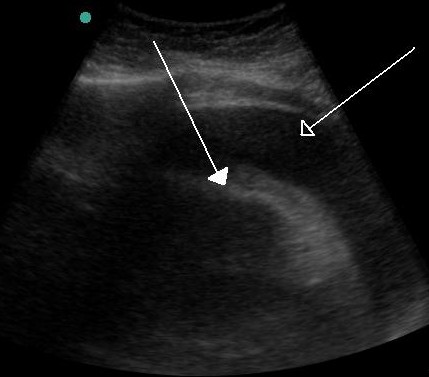Cardiac tamponade echocardiography and ultrasound
|
Cardiac tamponade Microchapters |
|
Diagnosis |
|---|
|
Treatment |
|
Case Studies |
|
Cardiac tamponade echocardiography and ultrasound On the Web |
|
American Roentgen Ray Society Images of Cardiac tamponade echocardiography and ultrasound |
|
Cardiac tamponade echocardiography and ultrasound in the news |
|
Risk calculators and risk factors for Cardiac tamponade echocardiography and ultrasound |
Editor-In-Chief: C. Michael Gibson, M.S., M.D. [1]; Associate Editor(s)-in-Chief: Priyamvada Singh, M.D. [2] Ramyar Ghandriz MD[3]
Overview
The role of echocardiography in the evaluation of the patient with pericarditis is to chracterize the presence, size, location and hemodynamic impact of a pericardial effusion. Tamponade is characterized by pericardial effusion, diastolic compression of the RV, diastolic compression of the right atrium (RA), plethora of the inferior vena cava and paradoxical septal motion.
Echocardiography/Ultrasound
Echocardiography
- As part of their recommendations for echocardiography, the American College of Cardiology (ACC), the American Heart Association (AHA), and the American Society of Echocardiography gave strong recommendations for echocardiography in pericardial diseases. [1][2][3][4][5][6][7]
- Two dimensional echocardiography and Doppler echocardiography should be done in all suspected cases of cardiac tamponade and pericardial effusion.
- Follow up echocardiography for assessment of impending cardiac tamponade is very helpful for determining patient's outcome.
- Echocardiogram helps in determination of pericardial disease's hemodynamic parameters and the difference of pressure in cardiac chambers..
Findings
- Presence of moderate and large pericardial effusion.
- Swinging of the heart within the effusion
- Reversal of right atrial and right ventricular diastolic transmural pressures.
- Cardiac chamber collapse is a common finding in cardiac tamponade.
- The right atrium and right ventricle are the most likely to collapse when intrapericardial pressure exceeds intracardiac pressure within any particular chamber.
- Right atrial collapse
- Right atrial pressure is minimal during diastole, however, pericardial pressure is maximal in diastole. Due to this fact, the first signs of collapse could be seen during right atrial diastole.
- A right atrial collapse that persists for > 1/3rd of the cardiac cycle is a good indicator of impending tamponade.
- Transient right atrial collapse can also occur normally.
- Diastolic collapse of the right ventricle is a very specific indicator for cardiac tamponade.
- Diastolic left atrial collapse is a very specific indicator for cardiac tamponade.
- Left ventricle collapse is uncommon due to the thickness of the ventricular wall.
- The respiratory variation of inflow and outflow across the mitral and tricuspid valves is increased.
- Normal respiratory variation in inflow and outflow across the mitral and tricuspid valves ranges between 20 - 25 percent.
- Mitral valve flow > 35 percent
- Tricuspid valve flow is 80 to 100 percent.
Pericardial Effusion and Cardiac Tamponade
In pericardial effusion, large hypoechoic regions are seen surrounding the heart with the presence of oscillatory motion of the heart.
The echocardiogram below demonstrates the swinging motion of the heart in cardiac tamponade. {{#ev:youtube|U4xQ3-VRiNg}}
Echocardiography of the heart with loculated pericardial effusion compressing the left ventricle. {{#ev:youtube|unnmmlCyyZM}}
Cardiac tamponade {{#ev:youtube|YWVI6rRTIzU}}
Cardiac tamponade {{#ev:youtube|_az8_V6bHE8}}
Left ventricular free wall rupture with cardiac tamponade {{#ev:youtube|g9TdKcFRiLo}}
Collapse of the right ventricle in a patient with cardiac tamponade {{#ev:youtube|dwJkJr00v5c}}

References
- ↑ Cheitlin MD, Armstrong WF, Aurigemma GP, Beller GA, Bierman FZ, Davis JL, Douglas PS, Faxon DP, Gillam LD, Kimball TR, Kussmaul WG, Pearlman AS, Philbrick JT, Rakowski H, Thys DM, Antman EM, Smith SC, Alpert JS, Gregoratos G, Anderson JL, Hiratzka LF, Hunt SA, Fuster V, Jacobs AK, Gibbons RJ, Russell RO (2003). "ACC/AHA/ASE 2003 guideline update for the clinical application of echocardiography: summary article: a report of the American College of Cardiology/American Heart Association Task Force on Practice Guidelines (ACC/AHA/ASE Committee to Update the 1997 Guidelines for the Clinical Application of Echocardiography)". Circulation. 108 (9): 1146–62. doi:10.1161/01.CIR.0000073597.57414.A9. PMID 12952829. Retrieved 2012-09-14. Unknown parameter
|month=ignored (help) - ↑ Argula RG, Negi SI, Banchs J, Yusuf SW (March 2015). "Role of a 12-lead electrocardiogram in the diagnosis of cardiac tamponade as diagnosed by transthoracic echocardiography in patients with malignant pericardial effusion". Clin Cardiol. 38 (3): 139–44. doi:10.1002/clc.22370. PMC 6711093 Check
|pmc=value (help). PMID 25694103. - ↑ Pérez-Casares A, Cesar S, Brunet-Garcia L, Sanchez-de-Toledo J (2017). "Echocardiographic Evaluation of Pericardial Effusion and Cardiac Tamponade". Front Pediatr. 5: 79. doi:10.3389/fped.2017.00079. PMC 5401877. PMID 28484689.
- ↑ Kapoor PM (2016). "Echocardiography for cardiac tamponade". Ann Card Anaesth. 19 (2): 338. PMC 4900338. PMID 27052078.
- ↑ Tsang TS, Oh JK, Seward JB (July 1999). "Diagnosis and management of cardiac tamponade in the era of echocardiography". Clin Cardiol. 22 (7): 446–52. doi:10.1002/clc.4960220703. PMC 6656203 Check
|pmc=value (help). PMID 10410287. - ↑ Hayes SN, Freeman WK, Gersh BJ (February 1990). "Low pressure cardiac tamponade: diagnosis facilitated by Doppler echocardiography". Br Heart J. 63 (2): 136–40. doi:10.1136/hrt.63.2.136. PMC 1024343. PMID 2317409.
- ↑ Jung HO (November 2012). "Pericardial effusion and pericardiocentesis: role of echocardiography". Korean Circ J. 42 (11): 725–34. doi:10.4070/kcj.2012.42.11.725. PMC 3518705. PMID 23236323.